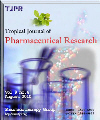
|
Tropical Journal of Pharmaceutical Research
Pharmacotherapy Group, Faculty of Pharmacy, University of Benin, Benin City, Nigeria
ISSN: 1596-5996
EISSN: 1596-5996
Vol. 13, No. 1, 2014, pp. 17-22
|
 Bioline Code: pr14003
Bioline Code: pr14003
Full paper language: English
Document type: Research Article
Document available free of charge
|
|
|
Tropical Journal of Pharmaceutical Research, Vol. 13, No. 1, 2014, pp. 17-22
| en |
Pharmacokinetic Study of a Capsule-based Chronomodulated Drug Delivery System of Salbutamol Sulphate in Rabbits
Qureshi, Mohd Javed; Ali, Javed; Baboota, Sanjula; Ahuja, Alka & Mallikarjun, Chitneni
Abstract
Purpose: To develop and determine the in vivo performance of a capsule-based pulsatile drug delivery system containing salbutamol sulphate
Methods: A controlled pulsatile release of drug after a programmed 4 h lag period was achieved from cross-linked gelatin capsule shells containing salbutamol pellets, and sealed with a suitable mixture of sodium alginate and ethyl cellulose as plug. In order to confirm the utility of developed system for the management of nocturnal asthma, a crossover study was conducted. six male rabbits were fasted overnight and divided into two groups comprised of 3 rabbits each. The individual rabbits were administered the developed pulsatile capsule and immediate release salbutamol capsule as reference, separately. Blood samples were collected from the ear vein of the animals into heparinized tubes and used to determine pharmacokinetic parameters, namely, maximum plasma concentration (Cmax), time to reach maximum plasma concentration (Tmax), and area under the plasma concentration - time curve (AUC0-∞) using a validated HPLC method.
Results: It was observed that drug release from the optimized time-controlled capsule stopped for a period of approximately 4.25 h with an average Cmax and Tmax of 271.54 ± 58.95 ng/ml and 6.00 ± 0.25 h. The AUC0-∞ of salbutamol after administration of the time-controlled pulsatile system was 2494.73 ± 525.95 ng h/ml while that of the immediate-release formulation was 2352.77 ± 432.51 ng h/ml. Using ANOVA at a significant difference of p < 0.05 (CI 95%), there was no significant difference for the AUC0-∞ between immediate release and the pulsatile capsule developed.
Conclusion: The developed system is capable of releasing salbutamol after a 4 h lag period and can be considered as promising delivery system for time-controlled (pulsatile) delivery of the medication for the management of nocturnal asthma.
Keywords
pH-controlled release; Lag time; Pulsatile release; Hydrocolloid plug; Nocturnal asthma
|
| |
© Copyright 2014 - Tropical Journal of Pharmaceutical Research
Alternative site location: http://www.tjpr.org
|
|
